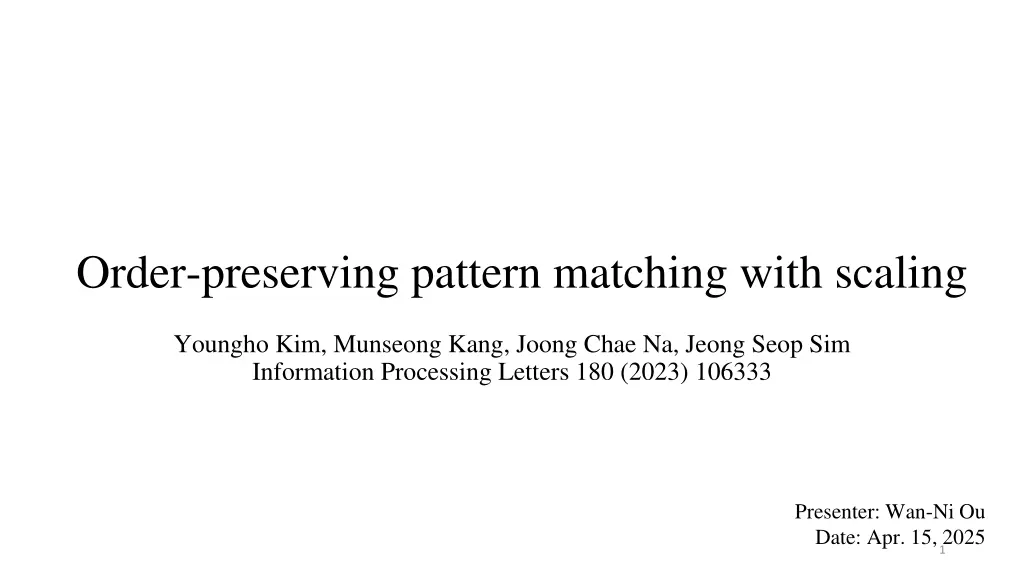
Order-Preserving Pattern Matching with Scaling in Information Processing
Explore the concept of order-preserving pattern matching with scaling as a novel criterion for approximate OPPM. This paper introduces the OPPM problem with scaling, presents an algorithm to solve it efficiently, and discusses various conditions and examples related to scaled order-isomorphism. Discover the innovative approach to handling approximate matching with relative orders and string lengths.
Download Presentation

Please find below an Image/Link to download the presentation.
The content on the website is provided AS IS for your information and personal use only. It may not be sold, licensed, or shared on other websites without obtaining consent from the author. If you encounter any issues during the download, it is possible that the publisher has removed the file from their server.
You are allowed to download the files provided on this website for personal or commercial use, subject to the condition that they are used lawfully. All files are the property of their respective owners.
The content on the website is provided AS IS for your information and personal use only. It may not be sold, licensed, or shared on other websites without obtaining consent from the author.
E N D
Presentation Transcript
Order-preserving pattern matching with scaling Youngho Kim, Munseong Kang, Joong Chae Na, Jeong Seop Sim Information Processing Letters 180 (2023) 106333 Presenter: Wan-Ni Ou Date: Apr. 15, 2025 1
Abstract Given a text T and a pattern P , the order-preserving pattern matching (OPPM for short) problem is to find all substrings of T which have the same relative orders as P . Recently, approximate OPPM that allows errors have been studied such as OPPM with k-mismatches. In this paper we define the OPPM with scaling which is a novel criteria for approximate OPPM by considering the relative orders of cusps and the scale of lengths of strings between them. Also we present an algorithm to solve the OPPM problem with scaling in O (n + m log m) time, which is the same time bound as the best known exact OPPM algorithm. 2
Scaled order-isomorphism (1/4) cusp X = 1, 10, 6, 2, 7 Y1= 3, 9, 8, 4, 6 Run-Length Condition 1: | XR| = | YR| and k XR[i] = YR[i]. Condition 2: XC YC. 3
Scaled order-isomorphism (2/4) X = 1, 10, 6, 2, 7 Y2= 2, 5, 10, 9, 6, 4, 3, 5, 7 cusp Run-Length Condition 1: | XR| = | YR| and k XR[i] = YR[i]. Condition 2: XC YC. 4
Scaled order-isomorphism (3/4) X = 1, 10, 6, 2, 7 Y3= 1, 5, 10, 8, 6, 3, 2, 4, 11 cusp Run-Length Condition 1: | XR| = | YR| and k XR[i] = YR[i]. Condition 2: XC YC. 5
Scaled order-isomorphism (4/4) X = 1, 10, 6, 2, 7 Y4= 1, 5, 10, 8, 6, 2, 4, 7 cusp Run-Length Condition 1: | XR| = | YR| and k XR[i] = YR[i]. Condition 2: XC YC. 6
Algorithm for the OPPM problem with scaling (1/3) Step1.1 Run-Length PQ= run-length J1 = { 1, 7 } Condition 1: | XR| = | YR| and k XR[i] = YR[i]. Condition 2: XC YC. 7
Algorithm for the OPPM problem with scaling (2/3) Step1.2 Cusp s Order PC[1..4] = 40, 23, 37, 28 J2 = { 3, 7 } J1 J2 = { 7 } Condition 1: | XR| = | YR| and k XR[i] = YR[i]. Condition 2: XC YC. 8
Algorithm for the OPPM problem with scaling (3/3) Step2. verification run-length TR[6] kPR[0] TR[10] kPR[4] + cusp order T = 34, 41, 17, 35, 24, 29 P = 35, 40, 23, 37, 28, 30 9
Time Complexity O (n + m log m) 10
Thanks 11
